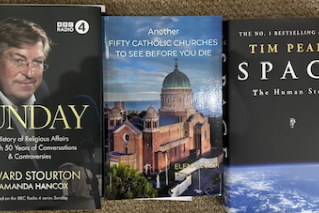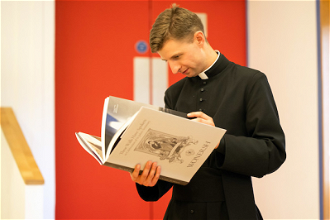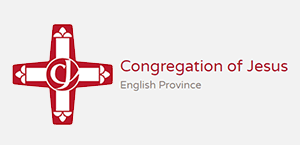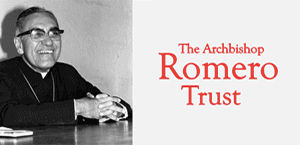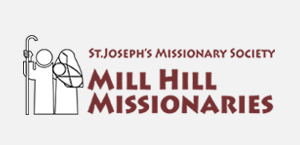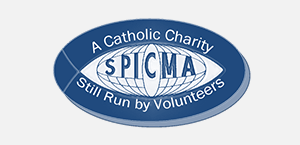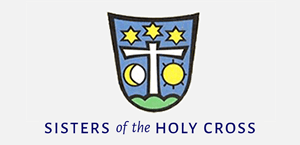Book: Fifty Catholic Churches to See Before You Die
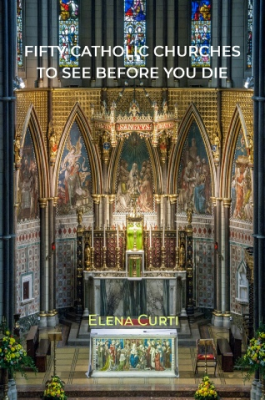
Churches are sanctuaries for our restless hearts seeking communion with the divine, places where the communities of the faithful come together in praise and thanksgiving.
In Fifty Catholic Churches to See Before You Die, Elena Curti celebrates beautiful churches in England and Wales, and explores the art and architecture of (in the words of the Missal) 'these places of awe', 'gates of heaven' and 'houses of prayer'.
Today, there are close to 3,000 Catholic churches in England and Wales and more than a quarter of them are listed, 34 of them Grade I and deemed of exceptional interest. Visiting churches is one of the most popular pastimes in Britain but Catholic churches are largely unknown outside their congregations. Curti says: "I knew about the most famous Catholic churches but as I travelled the length and breadth of England and Wales for my book, I realised how many more fantastic ones are completely unknown."
There are gothic revival churches, neo-classical, Byzantine, Arts-and-Crafts and Modernist, as well as a few built prior to the Reformation. The fifty are listed alphabetically by location. Beautifully and lavishly illustrated, each particular entry relates the church's history, architecture and artistic highlights. Every one has a compelling story, peopled by courageous old Catholic families; visionary priests and religious orders; local patrons; and poor Irish migrants who contributed their pennies, and often their labour, to raise their places of worship.
Curti warns: "Most of the 50 churches are well maintained but, for small congregations, especially in poor areas, the cost of caring for a listed building is often overwhelming. Several are struggling to raise money for urgent repairs and to win grants. At least one of my churches is on Historic England's 'At Risk' register. The Covid-19 pandemic will make fund-raising even more difficult in the years to come."
A couple of early entries serve to emphasise Curti's concerns. The island parish community of Amlwch has managed to fund-raise, dig deep, and save the modernist Church of Our Lady Star of the Sea and St Winefride whose outline 'resembles an upturned boat'. All Saints, Barton-upon-Irwell, is Edward Pugin's masterpiece and 'contains a sanctuary of extraordinary richness' but there are concerns for its long-term future, however, as the Friars Minor who run the church are in serious decline.
Our Lady and St Alphege in Bath is modelled on an early Christian basilica and is a masterpiece by Sir Giles Gilbert Scott who referred to the church as his 'little gem'. (There are 'hidden gems' a-plenty among Catholic churches notes Curti.) St Monica's, Bootle, has a 'stark beauty like that of a spectacular railway viaduct or pre-war power station'. Three elongated angels rise up at the west end with bowed heads and clasped hands.
In the neo-Classical St John the Baptist's, Kemptown, is a white marble monument to the church's benefactress, Maria Fitzherbert, who had married the Prince of Wales, later George IV, in secret. 'Theirs was a morganatic marriage valid in the eyes of the Catholic Church but illegal according to English law.'
John Coates Carter was the architect of the Abbey of Our Lady and St Samson, Caldey Island. "He plucked ideas from Italian villages and Bavarian castles, as well as from his hero, William Morris." Two ancient churches and priory ruins bear witness to the long history of Christianity on the island which has a landscape of cliffs, beaches and woodland. Pray for calm weather, however. As Caldey's poet-monk Br David Hodges writes: "Only a fool would visit ... an island where the boats/are all 'Weather Permitting'."
Sacred Heart and St Catherine, Droitwich Spa, pays homage to Ravenna with stunning mosaics made from eight and a half tons of Venetian glass. And there are deer here too, as in San Clemente in Rome. In St Catherine's chapel, the executioner's face is that of a parish priest with whom the illustrator Gabriel Pippet (also a children's book illustrator) quarrelled. Shades of medieval marginal humour here. 'Above the place where a group of chatty parishioners used to sit, he carved, on a capital, a man holding a finger to his lips.' And his own visual signature also appears in the church: the Angel Gabriel and a tiny pipit bird.
Lord Palmerston shelled out a pretty penny to defend the English coasts from Louis-Napoleon yet the Emperor came not as a conqueror but as an exile after humiliation by the Prussians. Napoleon III lies buried in the Abbey Church of St Michael, Farnborough. 'The building takes French Gothic to extremes with nine-foot gargoyles, flying buttresses, and multiple pinnacles bristling with crockets.'
St Peter the Apostle, Gorleston-on-Sea, is an extraordinary church of tapering arches designed by Eric Gill which anticipated the reforms of Vatican II by bringing the celebration of Mass close to the people. At the end of each entry Curti lists many more churches in the vicinity that are 'worth a detour'. Just down the road, she notes, in her most welcome 'supplementary visits' addendum, is the attractive Arts and Crafts decorated Our Lady, Star of the Sea, Lowestoft. 'For several years, the tower has been a favourite nesting place for kittiwakes.'
Gill's visionary ideas are honoured in the in-the-round churches of the modernist Blessed Sacrament, Gorseinon, 'its walls pierced by dozens of glorious crossed stained glass windows', and St Mary, Leyland, the runner-up in a 2013 competition to find the UK's best modern church. I was surprised that Worth Abbey's sublime round church was omitted by Curti. Here are swallows and martins all summer long rather than kittiwakes. Several Benedictine Abbey churches, and others run by the Oratorians, feature among the fifty.
In the guise of an Etruscan temple, All Saints, Hassop, stands amid rolling hills, grazing sheep and flowing streams in the heart of the Peak District National Park.
Curti adjudges Hull's rococo St Charles Borromeo to have 'an aura of Victorian music hall and fairground' and rightly advises a trip to nearby Beverley to visit its mediæval minster. There are humourous sculptures galore here of mediæval musicians and satirical misericords in the choir.
St Etheldreda's, Ely Place, is one of England's oldest Catholic churches and was restored to Catholic hands in 1873. The description of a jewel-box was never more apt than it is for the masterpiece that is St James's, Spanish Place, with its deep, dark vaulted interior setting off the brilliance of its furnishings and stained glass.
St Thomas of Canterbury, Newport, resembles a Nonconformist 'preaching box'. It was probably the first parish church to open after the Roman Catholic Relief Act of 1791. In contrast, opines Curti: 'Were it not for the cross on the conical bell tower, Quarr Abbey's Church of Our Lady might be a mosque or a Moorish fortress.'
There is further drama at St John the Baptist, Rochdale: 'Satan, with bat-like wings delivers a mock blessing to the lost souls recoiling from him in the flames. It is just one of the superb mosaics … covering every inch of the sanctuary and apse.' With nods to the Hagia Sophia in Istanbul, it brings Byzantine grandeur to Greater Manchester.
English Martyrs in Strood is dubbed 'asymmetrical perfection' by Curti. It was conceived by Eduardo 'Teddy' Dodds who was enthusiastic about the liturgical reforms then in the air. He died of cancer a year into the build but the inaugural Mass took place on the First Sunday of Advent, 1964, the very day the post-Vatican II Mass was introduced.
Walsingham's Slipper Chapel is another precious ancient Catholic church. It is the place where pilgrims removed their shoes to walk the last 'Holy Mile' barefoot. St Philip Howard lamented the destruction of the shrine by Thomas Cromwell's men in his tormented poem 'In the wracks of Walsingham.' One of his relics can be found among many others of the martyrs in the Tyburn Convent in London.
Curti rightly highlights the importance of the martyrs and the struggles of the faithful throughout. It is pleasing then, that she ends with a visit to the Hidden Chapel in the attic of the Bar Convent in York: 'an absolute gem, with a glorious neo-Classical dome concealed beneath the pitched tiled roof.' The sisters of the Bar Convent belong to the community founded by Mary Ward in 1609. Ward wanted her sisters to be active in the community. Her legacy today is two orders: the Congregation of Jesus and the Institute of the Blessed Virgin Mary. A convent and school prospered during the penal years. A reliquary in the chapel contains the hand of St Margaret Clitherow the local saint who was crushed to death in 1586 for sheltering Catholic priests.
A fascinating introduction contextualises the architectural history, and resultant architectural 'style wars', alongside church history. Also included are biographical notes of the principal architects and artists and a glossary of architectural terms.
Composed with panache and acute sensitivity, Curti's book bears superb witness to the beauty of these churches and provides an invaluable guide for those interested in exploring the architectural wonders of the Catholic Church. Conceived in a way that will facilitate days out, this is an ideal gift for Christmas and post-lockdown pilgrimages and peregrinations.
"I want my book to raise awareness of the most beautiful Catholic churches and encourage support for their conservation," she says. "After visiting my favourites, I am hoping that readers will want to go out and discover some of their own."
Fifty Catholic Churches to See Before You Die is published by Gracewing
For more information and to order see: www.gracewing.co.uk/page330.html




